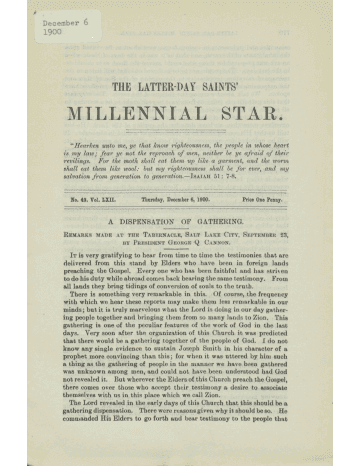Magazine
Corroborative Evidence

Title
Corroborative Evidence
Magazine
The Latter Day Saints' Millennial Star
Publication Type
Magazine Article
Year of Publication
1900
Editors
Lyman, Platte D. (Secondary)
Pagination
783–784
Date Published
6 December 1900
Volume
62
Issue Number
49
Abstract
The historical and religious portions of the Book of Mormon cannot be separated. External evidence verifies the historical portions. New York World reports a mound where a tablet inscribed with the Ten Commandments, “sarcophagi,” pottery and pictures that resemble that flood story, and characters resembling Egyptian and Assyrian writing were found.
CORROBORATIVE EVIDENCE.
Since that remarkable record of the early inhabitants of America—the Book of Mormon—was first published, there have been numerous discoveries in different parts of this continent, which are veritable testimonies of the truth of its historical narrations. North and South and Central America have all furnished relics of the past, in the shape of ruined cities and temples, aqueducts, canals, pottery, weapons of war, hieroglyphics, skeletons and remains of civilized and semi-civilized life and arts, that fit in with the theory and corroborate the testimony found in the Book of Mormon. But the religious portions of the record are so interwoven with the history it contains, that neither can be taken from the other without destroying the entire work. That which sustains one part also bears up the other, and gives evidence of the truth of the whole volume.
On of the most recent developments in this line of evidence, was published in the New York World monthly for October. It is of such interest to readers who pay attention to the antiquities of our country, and also to believers in the book revealed and translated by the gift and power of God, for the benefit of mankind in the latter days, that we reproduce it in full as follows; it is entitled “Tables of the Law in a Michigan Mound”:
“Wyman, Michigan, September 6.
“A tablet graven in an unknown language with what appears to be the Ten Commandments is the most interesting of many extraordinary antiquities from a mound north of this village, and now’ lying about in farmhouses and barns.
“Other curiosities from the mound are sarcophagi containing what appear to be burned human remains, flint spear heads scratched with rude pictures suggesting Noah’s flood, pottery, ornaments and weapons.
“Are these things relics of the mysterious civilization that dominated this land before the Indian arose to trample it under foot? Only an archaeologist can answer the question. That the curiosities were not ‘planted’ by some practical joker is proved by the fact that great pine trees some centuries old have grown over the mound since the articles were buried there.
“No inhabitant of this region can read the inscriptions on tablets or sarcophagi, but in a general way will recognize the characters and style of decoration as resembling Egyptian or Assyrian antiquities. This, to the lay mind, deepens the mystery and recalls the scientific theory recently exploited in the Sunday World that the American Continent was the cradle of the human race, and that the tide of emigration was from Alaska to Asia, instead of vice versa.
“Wyman is a lumbering town with two saw mills. All the country thereabouts has been lumbered off so thoroughly that nothing but legions of pine stumps meet the eye in every direction.
“More absorbed in thinking of the timber supply and the problem of livelihood, the local folk were only mildly interested when S.O. Scotford, then a painter living in Edmore, four miles south, disintered from the mounds some curious objects the like of which had never been seen before.
“Scotford is known as an eccentric character of a rather inventive mind, and his discoveries were viewed with scepticism. But other persons began to dig and find similar curiosities. The largest collection is that of Hiram J. Rich, a farmer near Wyman, who has several dozen of the relics stored in his barn, where the writer inspected them.
“All excepting the flint spear head are of burned clay. They were not placed haphazard in the mounds, but each one was confined in a small chamber of red clay. When taken out the clay was damp, but quickly dried.
“The tablet that seems to contain the Ten Commandments is patterned after the tablet represented in the familiar engraving of Moses on Mount Sinai. Arabic numerals are not used to designate, but lines like those used to tally scores in playing cards. The tablet is about a foot long and nine inches broad.
“No less suggestive of Biblical lore is the flint spear head. It is almost nine inches long and six inches broad, and has a flat polished surface. On this are scratched various scenes depicting the flood. Men are holding their arms above their heads as if to ward off the descending water. Scene No. 2 shows the ark on a mountain, and in the final scene troops of animals are filing out.
“The sarcophagi, or, rather, funeral urns containing ashes, invite conjecture. From a foot and a half high to two feet long their breadth and height average eight inches. The lid is stuck on by some unknown process, and is usually adorned with a reclining lion of Egyptian sculpture. The outside of the sarcophagi is covered with hieroglyphics.
“In the inside ashes of human bodies and bits of human bones are found. Similiar discoveries were made at mounds hard by Crystal Lake, some miles away, and at other places.”—Deseret News.
Subject Keywords
Bibliographic Citation
Terms of use
Items in the BMC Archive are made publicly available for non-commercial, private use. Inclusion within the BMC Archive does not imply endorsement. Items do not represent the official views of The Church of Jesus Christ of Latter-day Saints or of Book of Mormon Central.